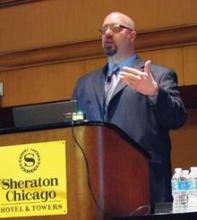CHICAGO – Rheumatic conditions associated with HIV infection have declined since the introduction of highly active antiretroviral therapy, but they remain common in patients with HIV infection.
Rheumatic conditions have been described in HIV infection since the 1980s, with a recent review suggesting an overall prevalence today of about 9% (Curr. Opin. Rheumatol. 2009;21:404-10).
In the era before widespread use of highly active antiretroviral therapy (HAART), the presentation of many individuals with HIV involved arthralgias, psoriatic arthritis, reactive arthritis, and diffuse infiltrative lymphocytosis syndrome (DILS). The prevalence of these syndromes decreased dramatically after the introduction of HAART in 1997. Findings from a recent chart review showed that 34% of 306 new HIV referrals to a Houston rheumatology clinic between 1994 and 1997 had DILS, compared with only 7.5% of 346 new referrals between 1998 and 2003 (odds ratio, 4.8; P less than .000001) (Arthritis Rheum. 2006;55:466-72).
In the HAART era, however, there has been an increase in osteoporosis and osteonecrosis in patients with HIV infection, which is actually thought to be secondary to some of the medications they take, said Dr. Michael P. Angarone, a clinical instructor in medicine–infectious diseases at Northwestern University in Chicago.
"Antiretroviral therapy has had a substantial impact on the development of rheumatologic conditions," he said at a symposium sponsored by the American College of Rheumatology.
The use of immunomodulating therapy can be challenging in patients with compromised immunity due to chronic HIV infection. Immunomodulatory therapy may decrease further their already lowered CD4 T-cell count, thereby increasing their risk for infection and the consequences of immunodeficiency. In addition, the therapy may actually promote viral replication.
There is a paucity of data in the rheumatology setting, but successful immunomodulatory therapy has been reported among HIV-infected patients in the transplant literature. CD4 counts and HIV viral loads remained stable, and there was no evidence of worsening HIV in 150 patients on a stable antiretroviral regimen who underwent kidney transplantation and received antithymocyte antibodies, calcineurin inhibitors, or high-dose corticosteroids (N. Engl. J. Med. 2010;363:2004-14). The one caveat to the prospective data is that those receiving antithymocyte antibodies initially experienced a decrease in CD4 T cells, but over time antibody levels slowly increased, said Dr. Angarone, who pointed out that this pattern is also seen in HIV-negative individuals who undergo antithymocyte antibody therapy.
"So the lesson we’ve learned from the transplant population is that we can indeed immunosuppress our HIV-infected individuals," he added.
Although anti–tumor necrosis factor (anti-TNF) therapies are being used to treat rheumatologic conditions, there have been no prospective trials of anti-TNF agents in HIV-infected patients and little in the way of adverse event reporting in patients with chronic viral infections. Initial thinking was that HIV utilizes TNF to replicate, and subsequently causes a decrease in CD-4 T cells, Dr. Angarone explained. A study involving an early TNF-alpha inhibitor, however, demonstrated no changes in CD4 cell counts or plasma HIV RNA levels, as feared, among six HIV-infected patients (J. Infect. Dis. 1996;174:63-8).
In addition, a recent case series reported excellent clinical responses in five of eight HIV-positive patients who received etanercept, infliximab, or adalimumab for a variety of rheumatologic diseases, including rheumatoid, psoriatic, and reactive arthritis; ankylosing spondylitis; and undifferentiated spondyloarthritis that was refractory to standard therapy (Ann. Rheum. Dis. 2008;67:710-2). CD4 counts reached a low of 240-923 cells/mm3 during treatment versus 268-974 cells/mm3 at baseline, while HIV viral loads remained undetectable in 50% versus 63% at baseline. No significant clinical adverse effects were reported. One patient had a substantial increase in HIV viral load, but this patient was not on antivirals, and the viral load decreased with anti-TNF discontinuation, Dr. Angarone pointed out.
"Immunomodulatory therapy appears to be safe in individuals with HIV infection. However, I think careful selection of patients needs to be undertaken, and you have to monitor these patients very closely," he said. "Ideally, you want an individual with a CD4 count greater than 200 [cells/mm3] and an HIV viral load that is undetectable [greater than 50 copies/mL] and you want that individual on antiretroviral therapy."
Given the variety of rheumatologic presentations of HIV, Dr. Angarone suggested that screening for HIV infection should be considered for all patients. Routine testing for HIV has been shown to be as cost effective as breast and colon cancer screening, and is recommended by the Centers for Disease Control and Prevention as part of routine screening in all health care settings for those ages 13 to 64, regardless of risk, he noted.
Dr. Angarone reported no relevant financial relationships.


